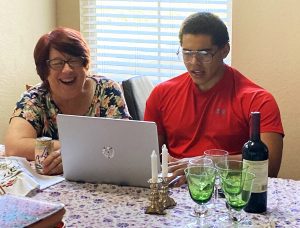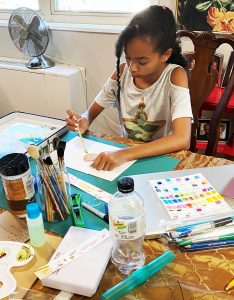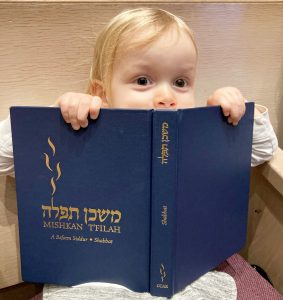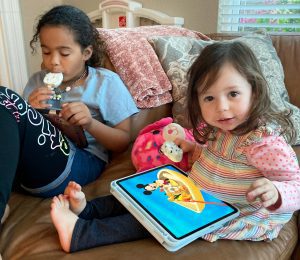
Apr 05 2024 Simple Ideas to Bring Shabbat to Life with Grandchildren
Ages:
3-8The Jewish Grandparents Network gratefully acknowledges Fred and Joyce Claar, who so generously supported the creation of this post.
Every week, Shabbat provides a time to rest, relax, reflect, and recharge — a moment to take a break from the hectic swirl of daily life. The ritual of Shabbat is one of the oldest traditions we have as a Jewish people. Traditionally, many people bring in Shabbat by lighting candles, blessing the wine or grape juice, and eating challah. Celebrated from sundown on Friday to nightfall on Saturday, Shabbat can be anything that is meaningful to us personally and to our family.
 Don’t worry about getting it “right” — make the tradition of Shabbat your own. Find even one small way to explore it as a time for you to connect with your grandchildren. Whether you’ve experienced Shabbat since you were a child, or you are encountering it with fresh eyes as a grandparent, there are many ways for you to creatively explore and experiment with Shabbat alongside your grandchild — in person or virtually.
Don’t worry about getting it “right” — make the tradition of Shabbat your own. Find even one small way to explore it as a time for you to connect with your grandchildren. Whether you’ve experienced Shabbat since you were a child, or you are encountering it with fresh eyes as a grandparent, there are many ways for you to creatively explore and experiment with Shabbat alongside your grandchild — in person or virtually.
You may choose to modify the activities below according to the age of your grandchild. You can adapt almost all of the activities if you are at a distance on Zoom, FaceTime, or WhatsApp. It is customary to observe Shabbat on Friday night. However, feel free to engage in any of these ideas on Saturday because it is still Shabbat until sundown Saturday night.
![]() Click HERE to download a free Shabbat Discovery Kit for grandparents and grandchildren.
Click HERE to download a free Shabbat Discovery Kit for grandparents and grandchildren.
 Create a weekly ritual welcoming Shabbat and wishing your grandchild Shabbat Shalom.
Create a weekly ritual welcoming Shabbat and wishing your grandchild Shabbat Shalom.
Perhaps it is a weekly FaceTime call, a text message, an e-mail message exchange, or a visit. Try to find a way to welcome Shabbat every week. If you miss a week that is okay, too. The idea is to begin to think together about the best way to mark Shabbat. Feel free to ask your grandchild how they would like for you to wish them Shabbat shalom.
For example, every week ask each other what you learned, or what was awesome about the week, or what was the funniest or most fun thing they did that week. You can use the template from our Shabbat Discovery Kit, found on pages 12 and 13, as a guide to your conversation. With younger children, you can each share the “rose” and the “thorn” of the week (the highlight and the low point) as a way to reflect together.
Create a parade.
Plan a parade with your grandchildren to welcome Shabbat with music and movement. Here’s an example of one playlist with upbeat Shabbat songs.
 Dress up the room.
Dress up the room.
For Friday night dinner or Saturday lunch, use objects that you use only on Shabbat, such as a cherished tablecloth or placemats or a bowl you made out of clay especially for Shabbat. You can create decorations or draw pictures with your grandchild that you hang up and display. Maybe you want to make place cards for the Shabbat table. Older children can write family members’ names. Younger children can create place cards with drawings of candles, challah, grape juice, flowers, and other decorations. Or they can draw place cards with family members’ pictures.
Light the candles creatively.
Whether in person or over FaceTime, find a way to make the ritual of lighting Shabbat candles fun for even the youngest children. Can you use a dragon hand-puppet and pretend that it “breathes fire” to light the candles? Or can you create a dance inspired by the gesture of bringing the light close to you with your hands? Collaborate with your grandchild to make this ritual your own.
 Welcome everyone to the Shabbat table.
Welcome everyone to the Shabbat table.
Our families are filled with many traditions, faiths, and backgrounds. Use Shabbat as a way to be inclusive of everyone in your family. Share that Shabbat is a time to disconnect from the world and recharge with each other. If you plan to say Shabbat blessings, recite them in English and explain the different components of the ritual (for example, blessing the candles, challah, and wine). Ask everyone at the table to share a hope they are bringing into the week ahead. Invite guests to share their traditions for family meals and celebrations from other faiths and cultures too.
Put your screens to sleep.
Create a “bed” for phones and iPads out of a shoebox and towels and make a ritual of turning off the screens and tucking them in for a rest too during Friday night dinner or on Saturday.
Take a moment to express appreciation for each other.
You can do this while lighting candles, or over dinner, or on a FaceTime call on Friday night or Saturday. Find some ideas for how to write and create your own unique blessings in the Shabbat Discovery Kit.
 Create a tradition between just you and your grandchildren.
Create a tradition between just you and your grandchildren.
It could be a story time. Each week, carve out some time to tell a story to your grandchild. If you are in person, you can create a cozy Shabbat fort out of pillows, blankets, and couch cushions as a place to read a story. You can snuggle up to read a favorite book, share a family story, or act out a story together.
Find ways to relax and recharge together.
How do you like to relax and recharge? How does your grandchild unwind? Ask each other to share ideas, and then explore them together. Take a nature walk, play video games, or stretch through yoga. Read a book or draw pictures together over FaceTime. Try to enter your grandchild’s way of finding rest and welcome them into your own favorite strategies.
Consider saying goodbye to Shabbat before starting the next week.
If your grandchild sleeps over on Saturday night or if you babysit them, this can be a fun way to start your time together. Shabbat traditionally ends on Saturday night with a ceremony called Havdalah, but you can find your own time to mark the transition from Shabbat to the start of the week.
 Make besamim (spices) for Havdalah.
Make besamim (spices) for Havdalah.
At the end of Shabbat, we smell pleasant spices called besamim to experience the last bit of sweetness before entering the next week. Mix your own besamim to mark the end of Shabbat together or bake cupcakes or cookies and use those smells for the spices or gather some fragrant flowers to mark the end of Shabbat. Find instructions in the Shabbat Discovery Kit. If you are at a distance, create your own besamim and share your creation over FaceTime. Describe to each other how it feels and smells.
Share a wish for the week ahead.
Connect with each other by FaceTime to share one thing you are excited about in the week ahead, as a way to say goodbye to Shabbat and officially start the week together.
Jonathan Shmidt Chapman is the founder of The K’ilu Company, activating Jewish early childhood education through theater and imaginative play. He is the 2023 recipient of the inaugural Jewish Family Education Fellowship from the Covenant Foundation. Jonathan is the author of Let There Be Play: Bringing the Bible to Life with Young Children, published by Behrman House. He also teaches coursework on Theater for Young Audiences at Northwestern University.
Photographic Credits
Lighting Shabbat candles banner by Stephanie Fink
Rosh Hashanah dinner by Benjamin Hansen
Shabbat helper by Terry Kaye
Child painting by Gail Buchbinder
Prayerbook by David Raphael
Story and ice cream time by Elisa Jensen
Havdalah by Jonathan Shmidt Chapman








 We use technologies like cookies to remember your preferences. Consenting to these technologies will provide you with a better browsing experience. JGN never shares information about your use of our website.
We use technologies like cookies to remember your preferences. Consenting to these technologies will provide you with a better browsing experience. JGN never shares information about your use of our website.